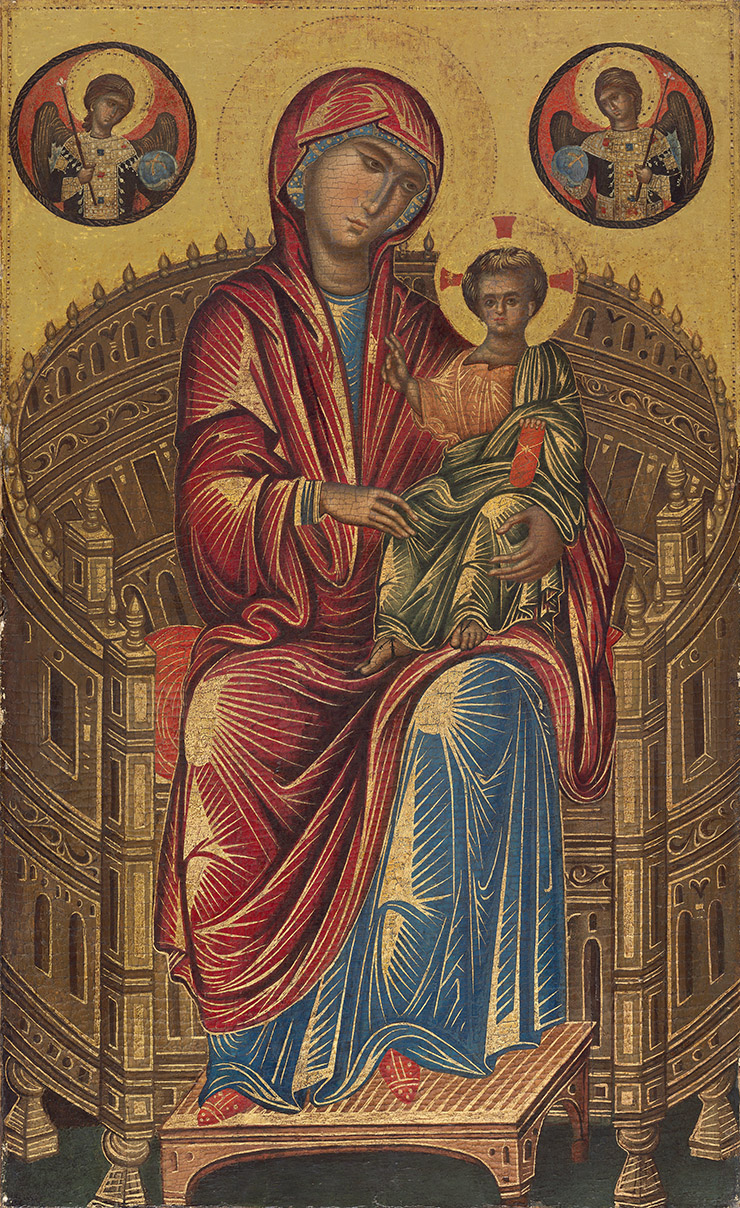 On each side of the throne are two tall and shorter finials. The space between them are the straight arms and sides of the throne. It is semi-circular chair. The artist was not able to represent the perspective of the chair accurately. Below is a 12th century icon showing the Theotokos and Christ on a curved wooden throne from Sinai,
On each side of the throne are two tall and shorter finials. The space between them are the straight arms and sides of the throne. It is semi-circular chair. The artist was not able to represent the perspective of the chair accurately. Below is a 12th century icon showing the Theotokos and Christ on a curved wooden throne from Sinai,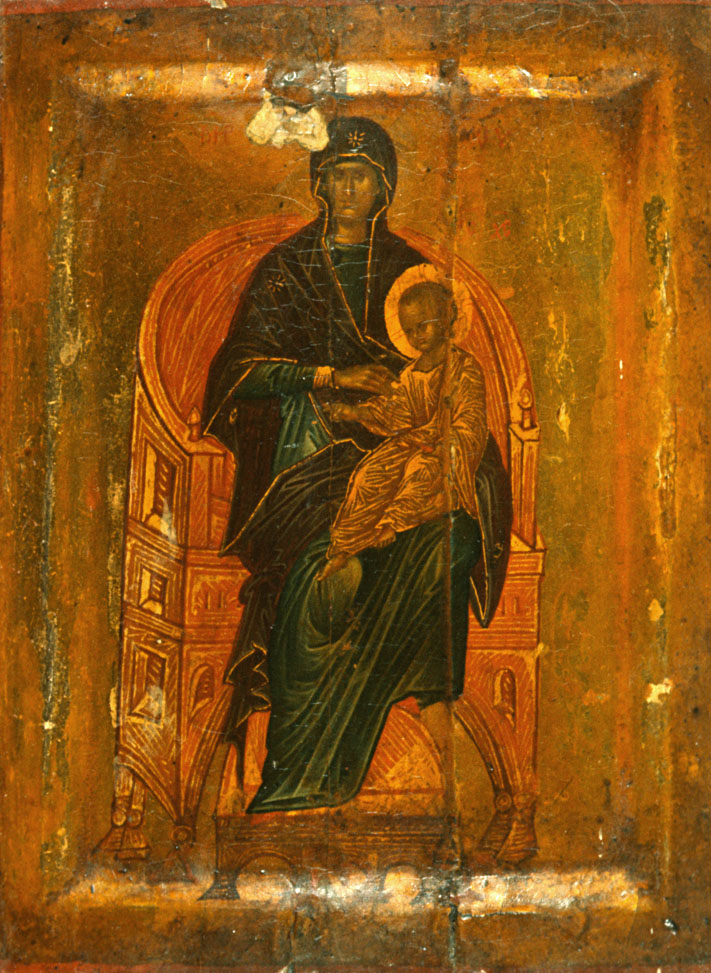
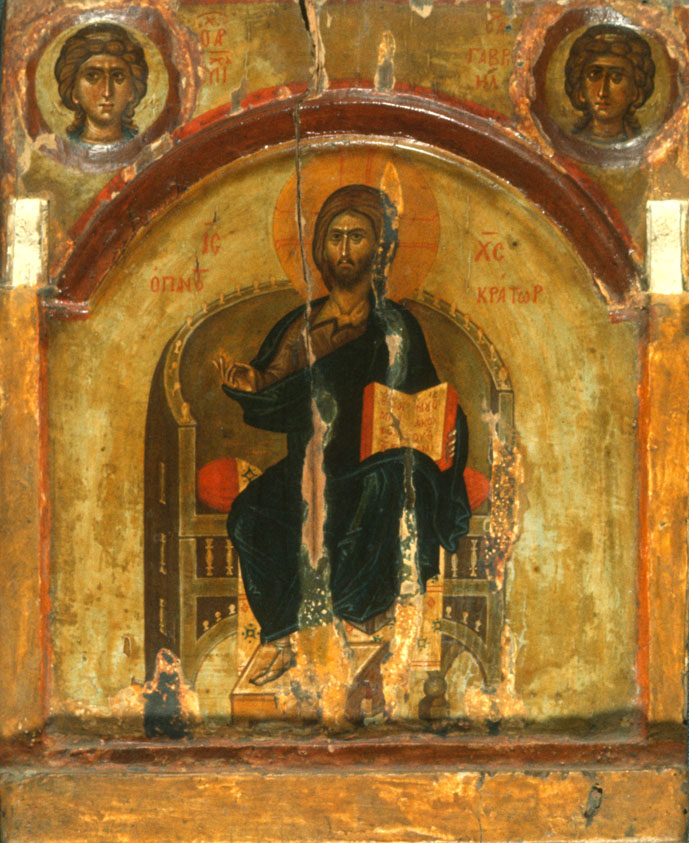
Above is a 12th century image of Christ on a curved back wooden throne with two archangels from Sinai.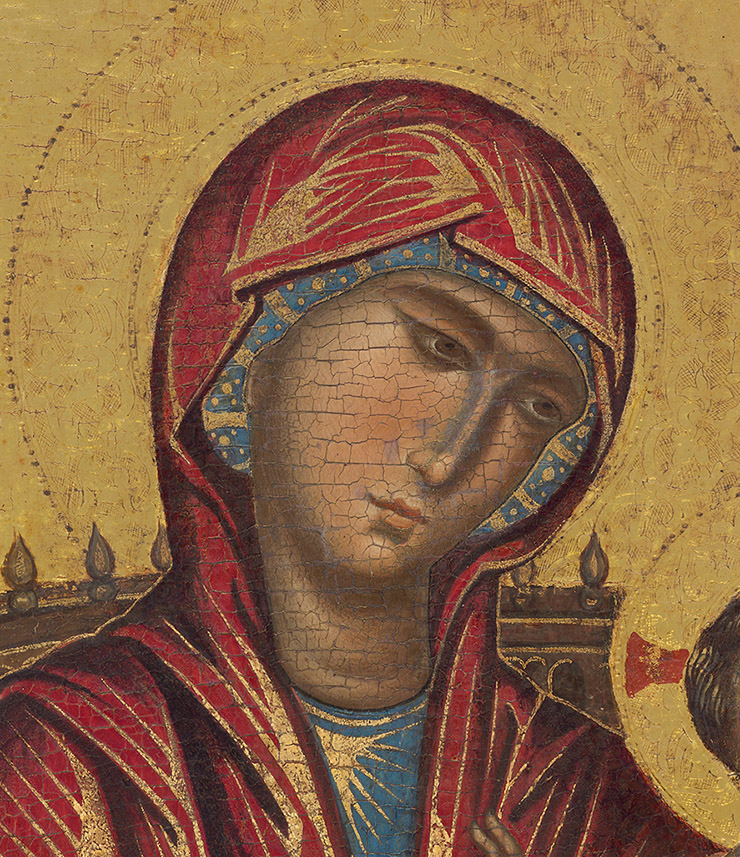 Above in this close-up you can see how the face of the Virgin as touched up with blue paint. This was done below and along the sides of the nose. Two odd patches were painted on the top of the cheeks. A small shadow was added to the left side of the lips. See how the pupils are drawn as dramatic ovals.
Above in this close-up you can see how the face of the Virgin as touched up with blue paint. This was done below and along the sides of the nose. Two odd patches were painted on the top of the cheeks. A small shadow was added to the left side of the lips. See how the pupils are drawn as dramatic ovals.
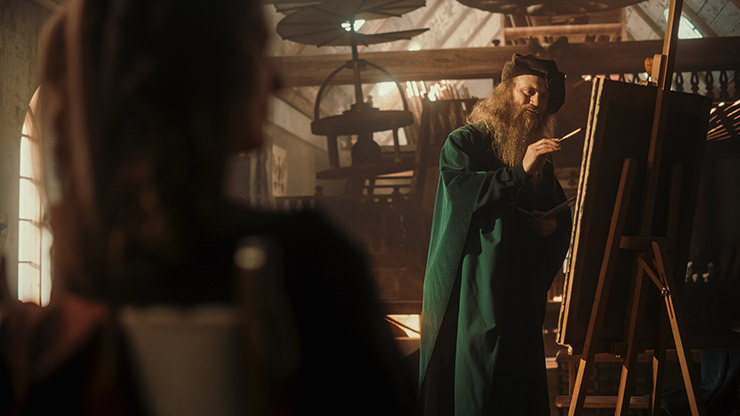
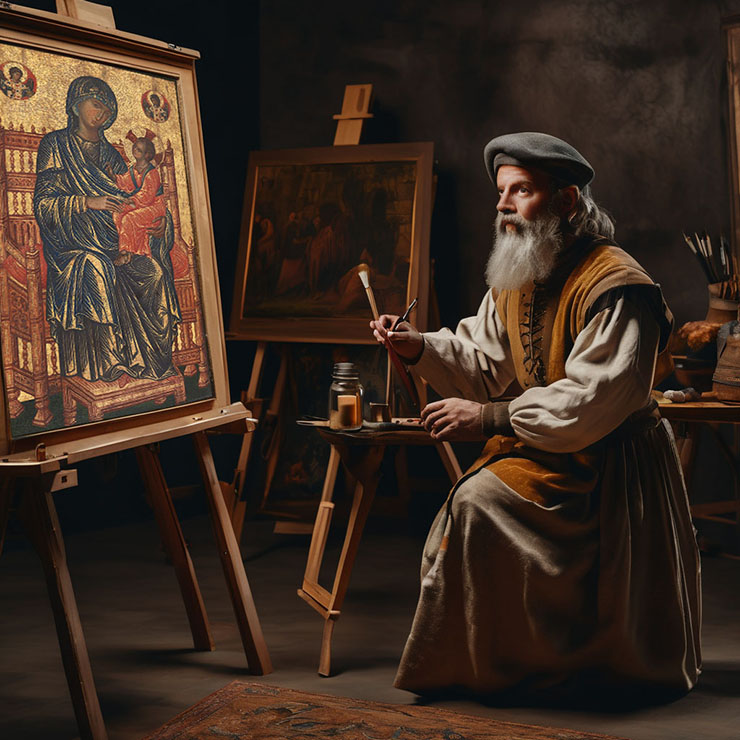 There are two famous Byzantine icons in the National Gallery in Washington D.C.. The so called "Mellon Madonna" is smaller than its sister icon - the "Kahn Madonna". In the Mellon icon the Theokotos and Christ are seated on a wood throne, which has been set with a pillow. the Virgin's feet are placed on a footstool. The pose of the figures is based on the famous Hodegetria icon, which the Byzantines believed had been painted by St. Luke. The Virgin looks at her Son, while Christ looks at the viewer. Enthroned icons of the Virgin and Child were very popular in Byzantium and came in many styles and postures with many types of thrones and chairs. This icon is an Imperial one showing the Theotokos and Child as part of a heavenly court with Archangels in attendance. Versions of this icon with Archangels in red medallions were very popular in the 12th century and were exported all over Christian Europe. Many examples have survived until today. Byzantine Emperors sent icons like this to friends and allies as gifts. Patriarchs also sent them to Catholic clergy, churches and monasteries in the West. Merchants in the art trade also exported thousands of icons as luxury Byzantine items every year. We have no record of how the Mellon and Khan icons arrived in Spain and came on the art market in 1912. They could have been there for hundreds of years before then.
There are two famous Byzantine icons in the National Gallery in Washington D.C.. The so called "Mellon Madonna" is smaller than its sister icon - the "Kahn Madonna". In the Mellon icon the Theokotos and Christ are seated on a wood throne, which has been set with a pillow. the Virgin's feet are placed on a footstool. The pose of the figures is based on the famous Hodegetria icon, which the Byzantines believed had been painted by St. Luke. The Virgin looks at her Son, while Christ looks at the viewer. Enthroned icons of the Virgin and Child were very popular in Byzantium and came in many styles and postures with many types of thrones and chairs. This icon is an Imperial one showing the Theotokos and Child as part of a heavenly court with Archangels in attendance. Versions of this icon with Archangels in red medallions were very popular in the 12th century and were exported all over Christian Europe. Many examples have survived until today. Byzantine Emperors sent icons like this to friends and allies as gifts. Patriarchs also sent them to Catholic clergy, churches and monasteries in the West. Merchants in the art trade also exported thousands of icons as luxury Byzantine items every year. We have no record of how the Mellon and Khan icons arrived in Spain and came on the art market in 1912. They could have been there for hundreds of years before then.
They are in excellent condition (especially the Kahn Madonna). There don't seem to be any markings for silver or gilt covers, which means they were not long enough in Constantinople to have been displayed in church. There are no physical indications that they were processional icons. There are mounts that show they were displayed on a wall or in a kiot, this could have happened anywhere. The idea that they were in a cloistered convent seems logical, since they were not then on public view in a cathedral. If they were in a convent perhaps they were brought by a woman who had taken vows there. While the icons were in private hands one could imagine the smaller Mellon Madonna in a private chamber like a bedroom and the Kahn Madonna in a private chapel.
Until they came on the art market the owners would have had no idea that thy were Byzantine in origin. In fact the earliest art historians who saw them thought they were early Italian works. Dereppes brought the painting to the attention of Duveen Brothers in a letter of 25 May 1918; he said he believed it to be by Pietro Cavallini and produced in the 13th century in Italy. At that time it was assumed that decorated and punched gold was an invention of the Italians. Now we know the technique was first practiced in Byzantium and was exported from there.
These icons come from the same artistic background as the mosaic of the Deesis in the South Gallery of Hagia Sophia. The Imperial archangels are the genuine expression of an artist who was completely conversant with 12th century court culture. Such works were produced under the supervision of the clergy of Hagia Sophia who ensured that the regalia was accurately depicted. These Imperial vestments were unknown outside Constantinople. The Russians did not reproduce them accurately when they copied icons with these motifs in the 12th century. A close look at the pearl trim of the Loros shows a familiarity with the way the pearls were attached, something only a person who had seen the regalia would understand. Once a year, at Easter, the regalia, crowns and other jewels were displayed in the North gallery of Hagia Sophia to the public. They were under the control of the clergy of Hagia Sophia and the Patriarch. One cannot over emphasize the influence of the clergy of Hagia Sophia on artistic style in Byzantium. The Imperial court was another source of artistic influence in both secular and religious art. This reached in peak during the reign of Manuel I Comnenus. I believe these two icons and the Deesis mosaic were created during his reign.
Below is a comparison of faces of the Virgin from Kahn, Mellon and the Hagia Sophia Deesis.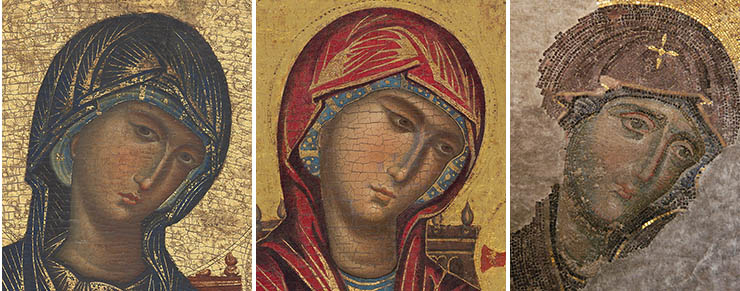
In 1912 the two icons appeared on the art market in Madrid. At that time it was claimed that both icons were found in the church, or convent, in Calahorra which is located in the province of La Rioja, Spain. There are no convents of churches that I have found that date back far enough to have been the original home of the icons in that city.
They were offered in a 1915 catalog of the Emile Pares Collection as primitive Italian works. They were purchased in September 1919 by Duveen Brothers, Inc., London, New York, and Paris. The Mellon icon was restored at least twice in the 1920s. In December 1936 Duveen sold them to the Andrew W. Mellon Educational and Charitable Trust, who then presented them to the NGA.
Before they entered the collection of the National Gallery there was a dispute among experts about the origin of the icon and the extent of the restoration. Not everyone believed the icon should be acquired by the NGA. Royall Taylor described it:
"Lorey has been no use whatever, except that he got some money out of Duveen. That was welcome, even at the price of having to exhibit his celebrated Byz. Madonna, vetted by B.B., which is a vile daub and heavily repainted at that. We had to resort to subterfuges in order to avoid reproducing it in the Catalogue."
Much rested on the opinion of Bernard Berenson (B.B.), the famous authority on Italian art. Duveen telegraphed the next day after his final word on the icon had been received: “happy to assure Mr Berensons opinion... remains unchanged stop Recent discoveries in cleaning St Sophia have served only to confirm Berensons attribution”. Berenson now described the icon as "color so gorgeous, so radiant, so pure” and “great precision, elegance, and suavity” in execution."
The icon came to the National Gallery after the Andrew W. Mellon Collection acquired and then presented it to the Gallery in 1937 as a gift. It was valued at $180,000. In the 1920's and 30's there had been an explosion of interest in Byzantine art. Many Americans were involved in the discovery of the mosaics of Hagia Sophia, which caused a sensation in the art world and had been sited by Berenson in his authentication of the icon as a Byzantine masterpiece. The National Gallery - and other American museums - were now acquiring icons and other Byzantine works for the first time as serious works of art.
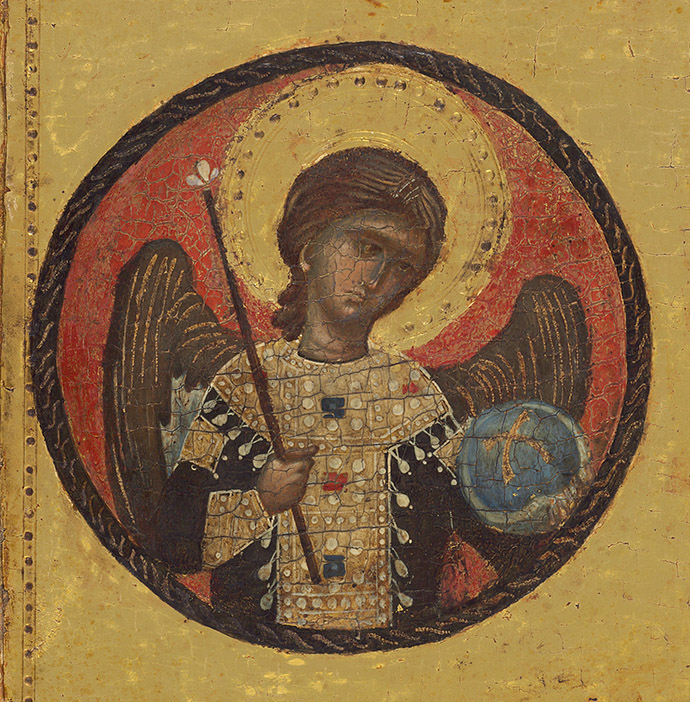 The archangels are dressed in Imperial clothing in purple decorated with gold, pearls and gems. This robe is called a Loros. They hold staffs and glass balls as emblems of power. The restorer has added blue shadows to the faces.
The archangels are dressed in Imperial clothing in purple decorated with gold, pearls and gems. This robe is called a Loros. They hold staffs and glass balls as emblems of power. The restorer has added blue shadows to the faces.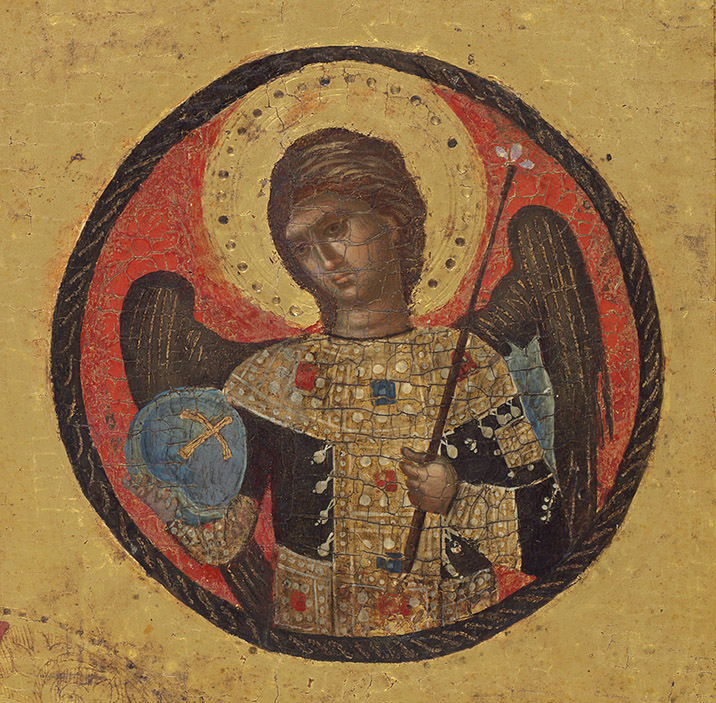 The archangel on the right had a crack running right through it. The restorer has painted in the cloth but omitted the pearls that hung from the Loros. The restorer as also misunderstood how the bottom of the left wing would have gone and has improvised it with a curve rather than going straight down.
The archangel on the right had a crack running right through it. The restorer has painted in the cloth but omitted the pearls that hung from the Loros. The restorer as also misunderstood how the bottom of the left wing would have gone and has improvised it with a curve rather than going straight down.
The icon is painted in egg tempera on a linden wood panel. The painted surface is 82.4 x 50.1 cm (32 7/16 x 19 3/4 in.) overall: 84 x 53.5 cm (33 1/16 x 21 1/16 in.) It has an attached frame which is 90.8 x 58.3 x 7.6 cm (35 3/4 x 22 15/16 x 3 in.)
The Mellon icon is usually referred to as Madonna on a Curved Throne. It is a pretty icon that is seen by millions of visitors to the National Gallery every year. The Virgin and Child are seen frontally. They are attended by two archangels dressed in Imperial regalia.
Mary and the Christ Child on seated on a round back wooden throne, the tilted angle of the back of throne is a result of the lack of knowledge of perspective by the original artist who created this icon theme. This icon is most certainly a copy of another icon and it was probably duplicated hundreds of times in different sizes. These copies might not have been identical. An artist or workshop might make minor changes to the original prototype. Certain icon themes or motifs became associated with workshops. Workers and painters did different parts of an icon. One artist did the thrones and clothes, another did the faces, hands and feet. A number of faces could be produced in one day, one artist says he could easily do 7 in one day. This meant that artists became extraordinary experts in specific painting techniques, styles and the expression of emotions.
Before an icon was painted there were number of steps required to prepare the panel. Workshops ordered large quantities of wood panels from professional carpenters. One carpenter produced 1,000 wood panels in set sizes as a single order from a workshop. The panels where usually made of hardwoods like linden and poplar. Panels were often made of multiple pieces of wood that had been mortised and glued together. A single panel could be made from multiple kinds of wood. Constantinople was surrounded by great forests that supplied all kinds of wood to the city. It ws easy to transport by land or sea. The wood used to create the panels was cured for long time before it was crafted. Byzantine icons usually have wood braces attached to the top and bottom of icons to prevent warping or slipping. These were often painted red.
The wood panels were delivered to the icon workshops where they were prepared by gluing linen cloth to sides of the the icon that would be painted. These could even be old worn bits of cloth. In some cases the cloth was only glued within the impressed "ark" with the panel of wood where the painting would go. Usually the cloth would be glued right over the frame of the icon. The next step was to paint many layers of gesso over the cloth and wood panel and polish the surface. The gesso was mixed with an animal skin glue an heated before it was applied. It was essential that the surface be absolutely smooth to receive the drawing.
Many icons were ordered by subject. Workshops had huge collections of drawings and patterns they used. For some special orders tracings were taken from holy icons directly. Drawings were drawn into the surface of the icon using a stylus or traced using paper patterns. Some artists were able to draw freehand, but the assembly line method of creation meant the painters received icon panels pre-drawn and gilded.
Gold was beaten into very fine sheets and applied to the surface prepared with a bole-clay in various under colors, usually yellow, orange or red. The bole was mixed with animal skin glue and heated before it was applied. The surface of the icon was prepared in advance with dawn halos and other ares that were to be decorated with gold. Gilding was a highly skilled craft. The Byzantines originated practice of tooling of delicate patterns in gilding. Gold leaf came in different thicknesses and in yellow or red tones. Silver gilding was also employed to save money. In the late 11th and 12th centuries there was a shortage of gold which made silver gilding an alternative when gold could not be found. Once the silver was applied multiple glazes in yellow orange or red could be applied that duplicated gold. Once the icon panel had been gilded the gilded areas received special polish of the gold areas. This burnishing was done with agate or bone tools. It actually polishes the gesso underneath the gold leaf.
Both the Virgin and Christ Child's clothes were adorned with gold decoration - called chrysography - that was added after the painting was completed. This is an example of the extraordinary talent Byzantine painters had in applying these. The method to create them is unforgiving and can only be done once. The pattern must be perfectly executed. These added to the modelling of the bodies in natural or candle light and created a 3-d effect.
Every year Byzantium consumed a huge amount of gold leaf which was also used to create gold glass mosaic The Byzantines were also experts at creating gilt-silver items.
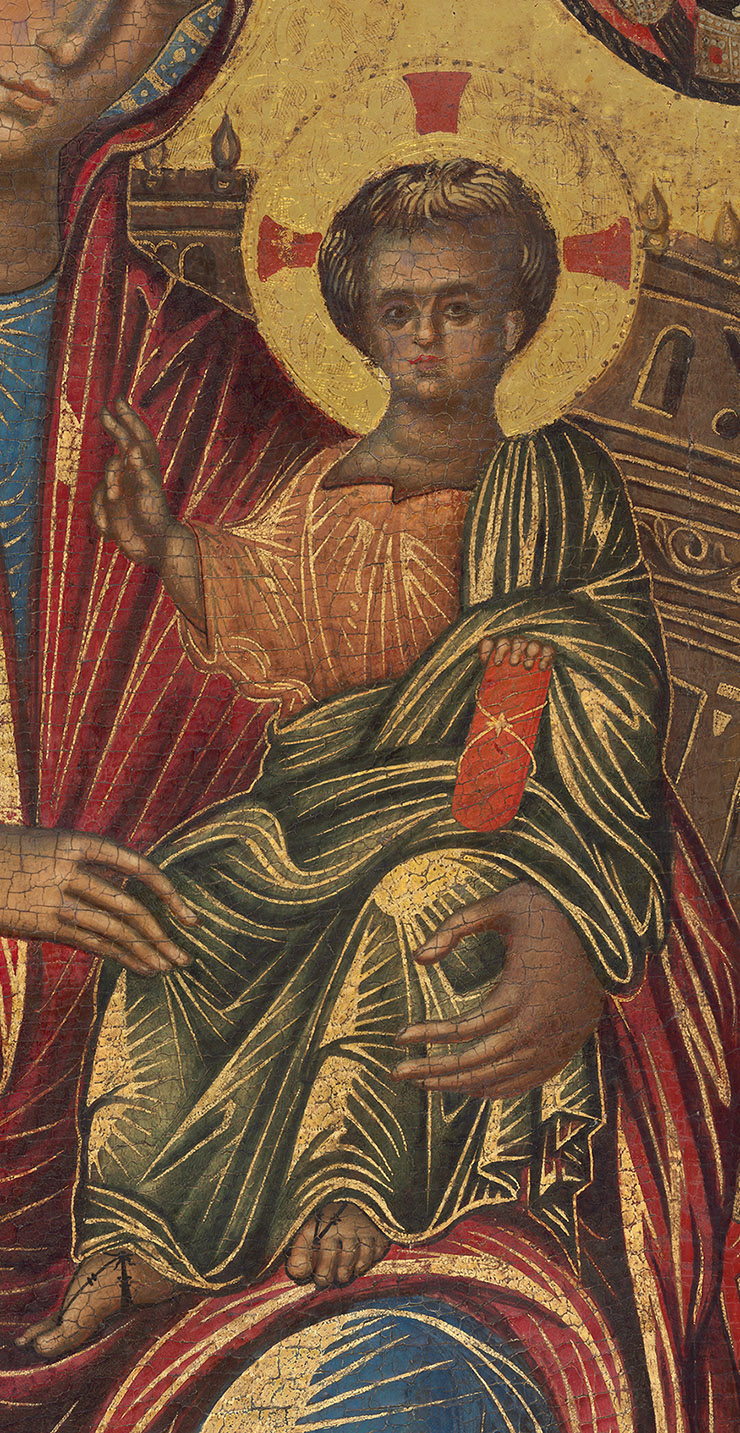 Here you can see two lines in the folds where the colored tunic bands of Christ was. The restorer has repainted these into the tunic. All of the blue in His face and hands has been added in the retouching of it. The Virgin's hands have also been defaced with blue shadowing. The red cross arms in the halo were added, the original icon may have had them. The restorer added them copying the Kahn Madonna. The halo of Christ cuts into his shoulders on both sides. This was another mistake of the restorers. I have never seen this in a Byzantine icon before. In touching up the green tunic the restoration has used a 19th century green viridian pigment.
Here you can see two lines in the folds where the colored tunic bands of Christ was. The restorer has repainted these into the tunic. All of the blue in His face and hands has been added in the retouching of it. The Virgin's hands have also been defaced with blue shadowing. The red cross arms in the halo were added, the original icon may have had them. The restorer added them copying the Kahn Madonna. The halo of Christ cuts into his shoulders on both sides. This was another mistake of the restorers. I have never seen this in a Byzantine icon before. In touching up the green tunic the restoration has used a 19th century green viridian pigment.
Below are the colors found in an 1982 analysis of the icon including microscopy and XRF - energy-dispersive x-ray fluorescence:
1. Red robe of Virgin - organic Red Lake and Lead White - Pb, Fe, Ca, Cu, Zn - organic lake (est)
2. Blue skirt of Virgin - Ultramarine (lapis) - Pb, Fe, Ca, Cu, Zn - ultramarine (est)
3. Green tunic of Christ - Prussian blue and Viridian - As, Ca, Fe, Cu, Zn - the original green was probably orpiment and copper blue - the restoration was done in 19th-century green
4. Orange robe of Christ - Au, Hg, Fe, Pb, Ca Cu, Zn - Vermilion
5. Primer layers - Ground gypsum
6. Throne - iron oxides
Icons were painted in egg tempera. Pigments are mixed with egg yolks and a bit of oil. Some pigments, like Ultramarine, are difficult to wet or mix with the yolk and take a lot of time to prepare. There were assistants in the workshops whose job was to prepare colors for the artists to work with. Some colors - like ochres and earth pigments - were inexpensive and would be made locally. Others - like Ultramarine made from Lapis Lazuli - came from distant lands. Some colors - like blue azurite - were made from crushed glass or the wings of beetles. Rare and expensive colors - were avoided. Red vermillion was made from lead sulfate. Natural red lake was made from madder. Greens were notoriously unreliable pigments that faded or changed color. Lead white was mixed into vermilion and lapis to make bright reds and lush blues. Some of these colors were quite toxic and the workers who prepared them put themselves in danger of poisoning. Some pigments like Ultramarine lapis required a lot of preparation to grind down into the smallest grains. Ultramarine came in grades according to degree of blueness and size of grain.
Once an icon was painted it was glazed with a fine oil.
Hagia Sophia was a multi-church operation that also ran the offices of the Patriarch from there. The largest customer of icons in Constantinople were the clergy and canons of Hagia Sophia who ordered tens of thousands of icons every year from the city workshops. These icons were used in the services of Hagia Sophia or its sister churches, given as gifts or sold in their shops. Hagia Sophia also produced vast quantities of candles and oils for lamps. Tour guides in Hagia Sophia could get any icon you wanted for immediate purchase, even for obscure saints. Icons were an inexpensive, but highly valued gift from Church authorities and the Patriarch himself, who sent out icons to distant places like Kiev and Novgorod in Russia. Thousands of Byzantine icons traveled by merchant ships all over the world.
The production of mosaics, fresco painting and icons for big church projects were sourced by building contractors, directly from workshops. Teams traveled all over the empire - and places like Kiev, Sicily and Venice - to create decorations for churches and palaces. Sometimes workshops traveled with their own supplies, other times contractors provided them. Tons of gold and glass mosaic had to be produced to decorate even the smallest church and needed to be provided before the work began. Transportation was provided by ships for ports, while teams of mules had to haul it to the work site.
The Mellon icon suffered several serious splits which have damaged the painting, especially on the right side. This required the extensive repainting of Christ and right side of the Theotokos. The restoration followed the drawing of Christ's green tunic almost exactly, however modern colors including Prussian Blue and Viridian were used. All icons of Christ show two stripes on his tunic. These seem to have vanished, they were most likely over-painted by accident when the restorer mistook them for folds. The regilding of Christ's halo has cut into His shoulder on both sides. the halo has also messed up the profile Christ's hair. Christ always has curls on the back of His neck and these are now gone. The regilding bled into the throne and was over painted to correct it.
The red robes of the Virgin, which were damaged by the crack, were expanded with two new folds over the brown throne. I don't know why this was done. These new folds do not make any sense in the original design of the icon.
The right archangel has been damaged by the crack and has been repainted on the left side. This restoration ignored the missing pearls on the Imperial Loros and left the space blank. I don't know why. The globes in the hands of both archangels and parts of their wings seen to have been brightened and repainted. Blue shadows have been added to the faces and hands to make it match the Kahn Madonna.
The bottom green field has been repainted, probably to conceal the cracks and brighten it. it looks like the field had darkened and faded into a brown color. Something has been done to the footstool which made the original paint swell. The gold highlights now go into the cracks - maybe they have been redone, too.
The entire area of gilding at the top has been replaced, at least once. underneath the entire icon was a layer of linen. This was cut away during and a new layer of bole was laid down The gilding was redone with ornament to match the Kahn Madonna.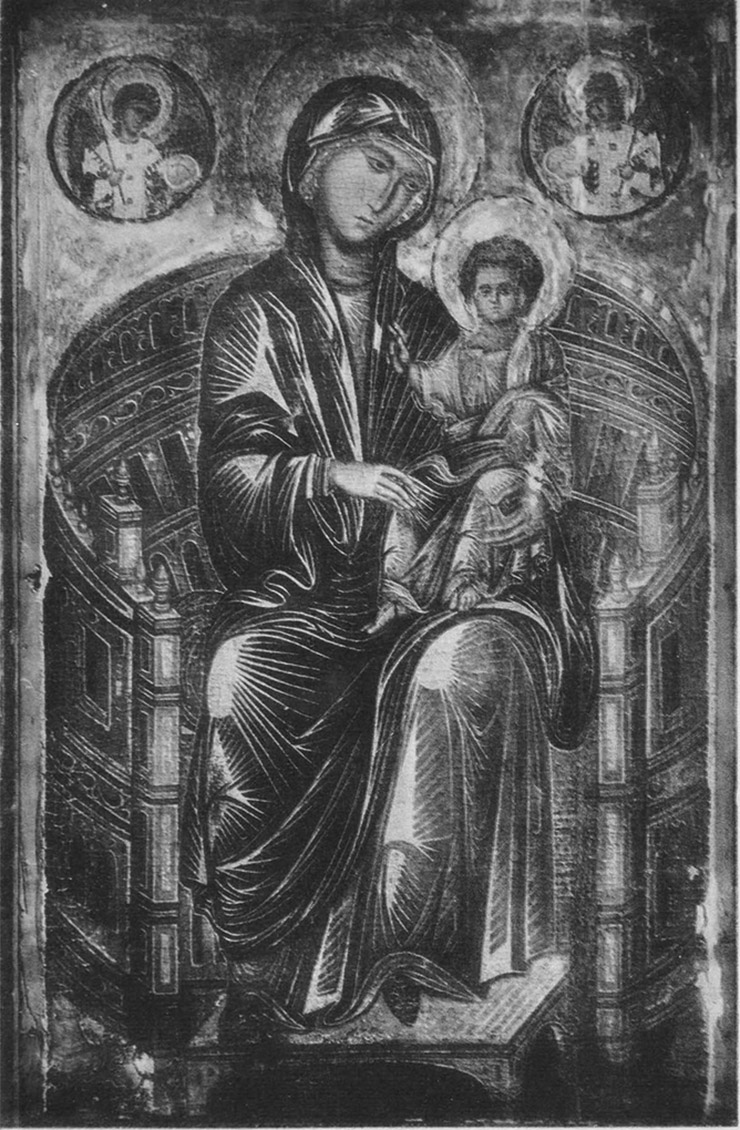 Above you can see a black and white image from around 1912 which shows the Mellon Madonna before its restorations. This restoration was not documented so this is all we have to compare for changes that were made to it. The first restoration repaired the cracks wood support, renewed the gilding for the first time, and restored the top of the throne with its finials. Several times the faces, hands and feet were retouched. All of these restorations were completed by 1928. The work done on the faces and hands was badly done in blue. The face of the Virgin has had the shadows on the nose marked up with blue lines and the cheeks still have two disturbing marks in blue left behind. Christ's face has been scarred with blue modelling, as well.
Above you can see a black and white image from around 1912 which shows the Mellon Madonna before its restorations. This restoration was not documented so this is all we have to compare for changes that were made to it. The first restoration repaired the cracks wood support, renewed the gilding for the first time, and restored the top of the throne with its finials. Several times the faces, hands and feet were retouched. All of these restorations were completed by 1928. The work done on the faces and hands was badly done in blue. The face of the Virgin has had the shadows on the nose marked up with blue lines and the cheeks still have two disturbing marks in blue left behind. Christ's face has been scarred with blue modelling, as well.
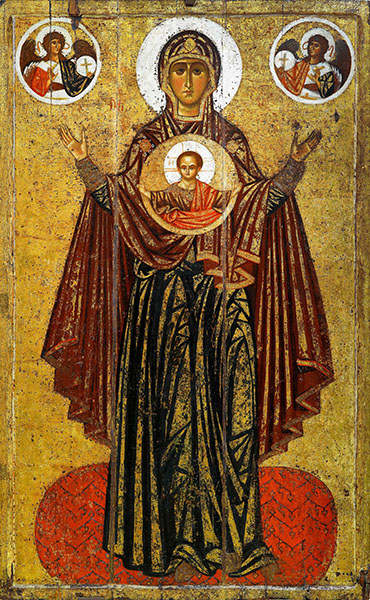 The Great Panaghia
The Great Panaghia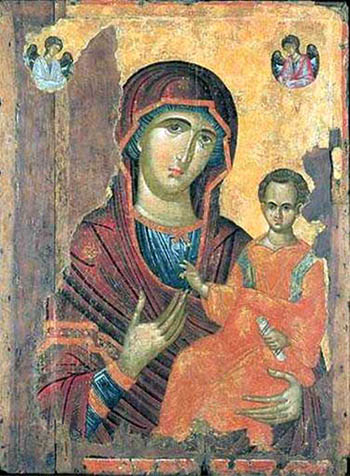 Hodegetria
Hodegetria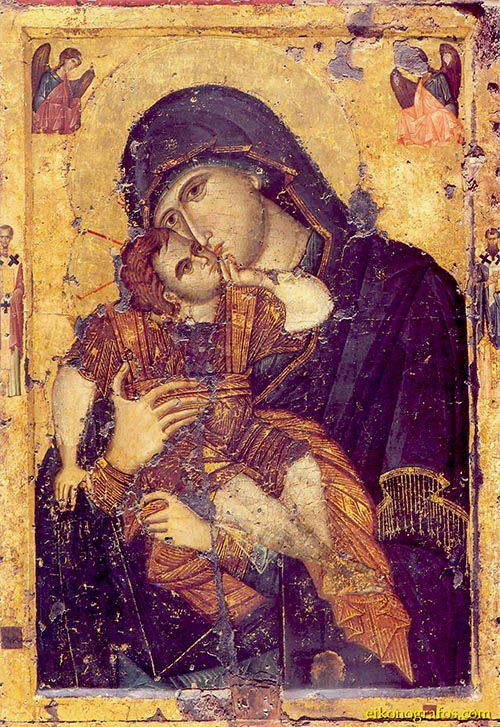 The Playing Child
The Playing Child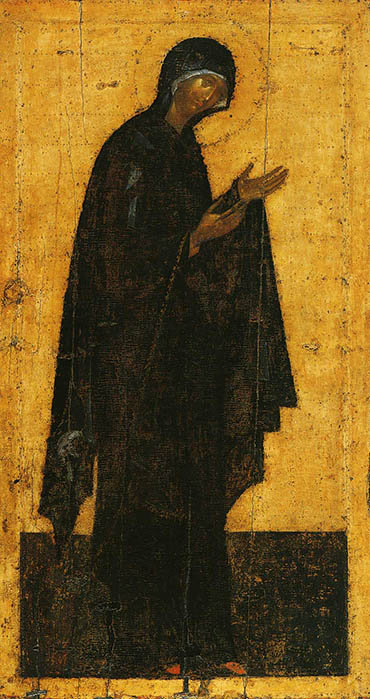 Andrei Rublev Theotokos
Andrei Rublev Theotokos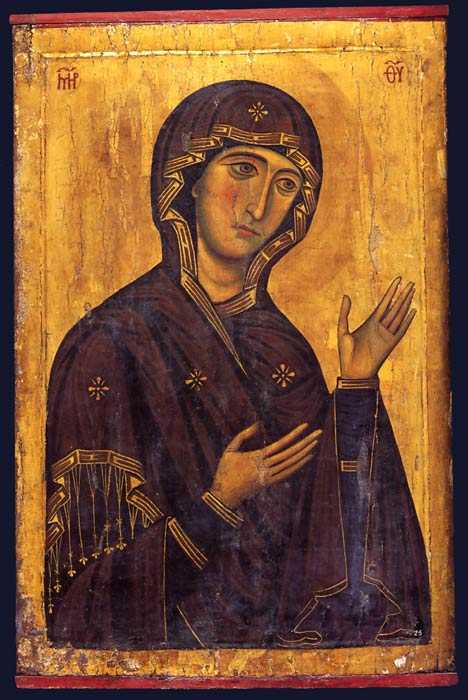 Sinai Theotokos
Sinai Theotokos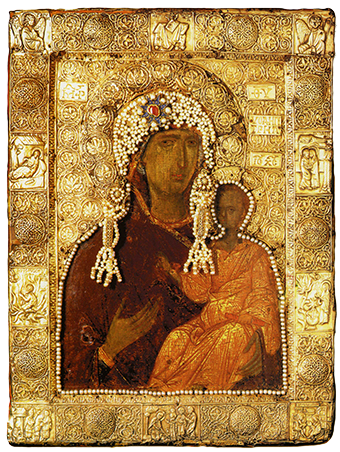 Hodegetria
Hodegetria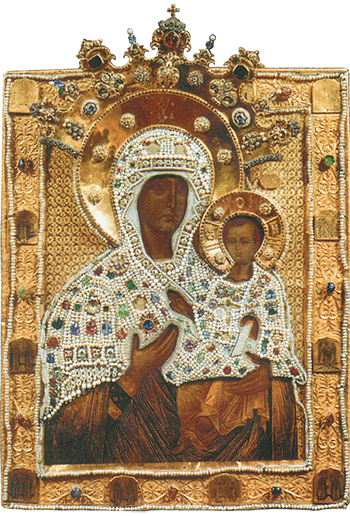 Hodegetria
Hodegetria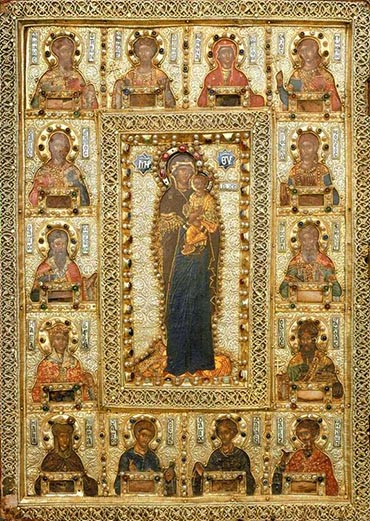 Palaiologian Reliquary
Palaiologian Reliquary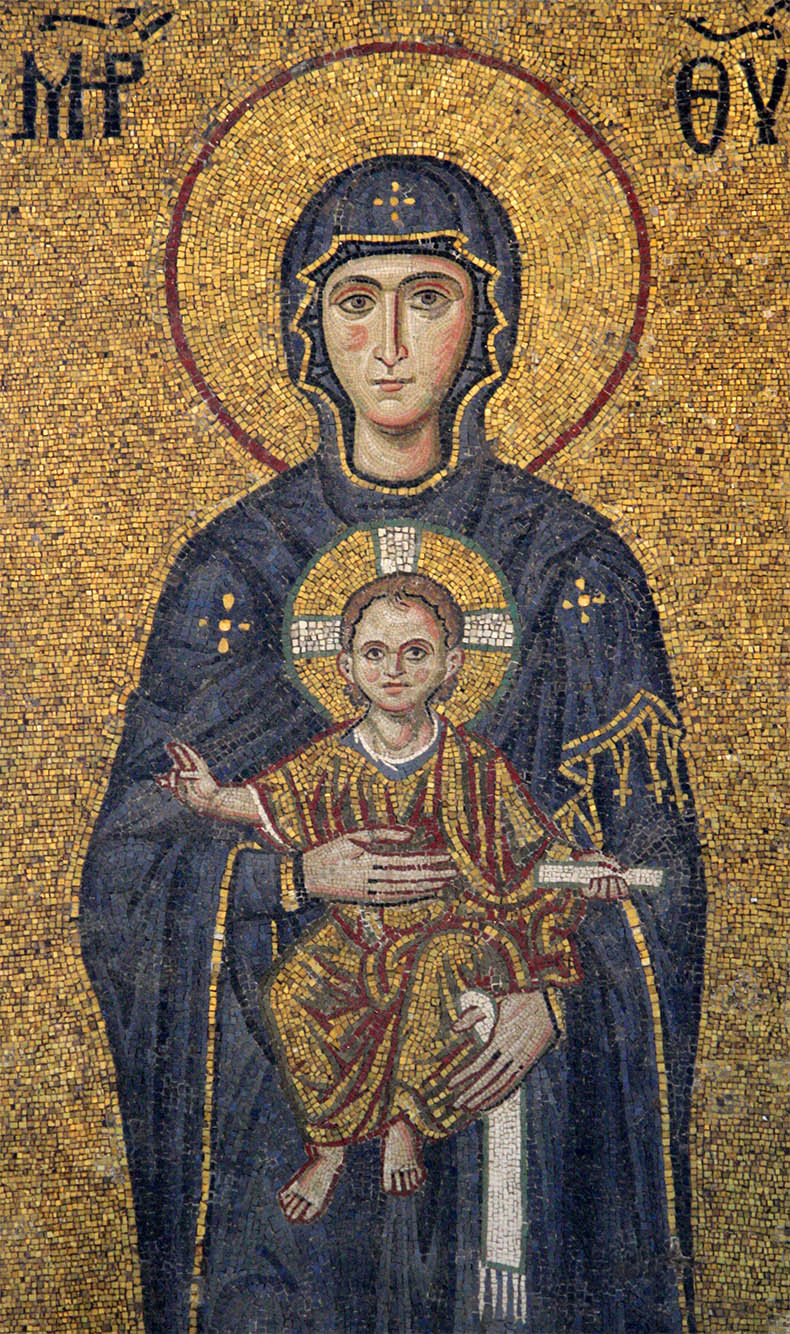 Hagia Sophia Theotokos
Hagia Sophia Theotokos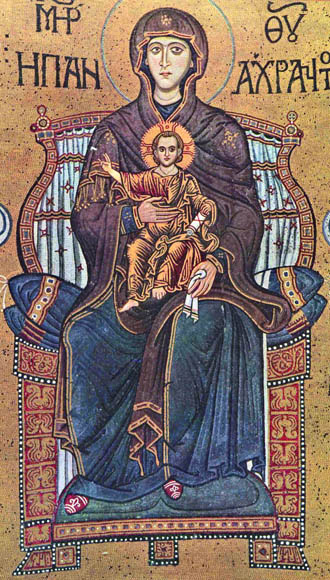 Monreale Theotokos
Monreale Theotokos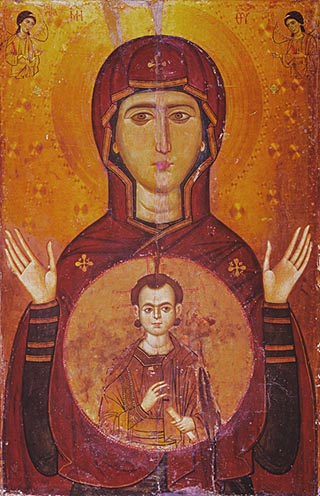 Theotokos Blachernitissa
Theotokos Blachernitissa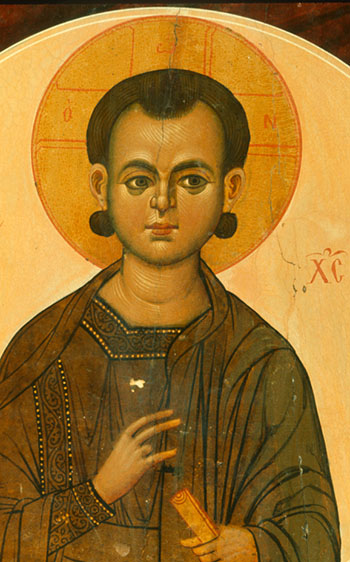 Here is a close-up showing Christ. He is always shown having high forehead like this. Here we can also see two curls, one on each side of his neck. Compare this to the head of Christ in the Mellon icon and you can see how the restoration botched the shape of the head and the hair.
Here is a close-up showing Christ. He is always shown having high forehead like this. Here we can also see two curls, one on each side of his neck. Compare this to the head of Christ in the Mellon icon and you can see how the restoration botched the shape of the head and the hair.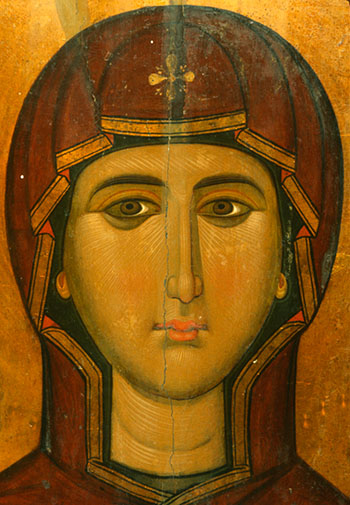
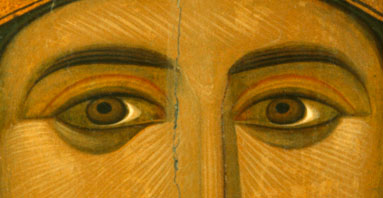 The three previous pictures were taken before the icon was restored, removing later touch-ups. This icon is really large, the highlights have been applied in many broad strokes.
The three previous pictures were taken before the icon was restored, removing later touch-ups. This icon is really large, the highlights have been applied in many broad strokes.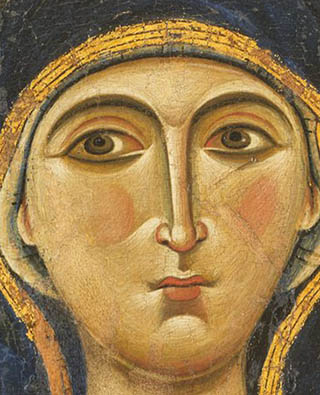






 There are two famous Byzantine icons in the National Gallery in Washington D.C.. The so called "Mellon Madonna" is smaller than its sister icon - the "Kahn Madonna". In the Mellon icon the Theokotos and Christ are seated on a wood throne, which has been set with a pillow. the Virgin's feet are placed on a footstool. The pose of the figures is based on the famous Hodegetria icon, which the Byzantines believed had been painted by St. Luke. The Virgin looks at her Son, while Christ looks at the viewer. Enthroned icons of the Virgin and Child were very popular in Byzantium and came in many styles and postures with many types of thrones and chairs. This icon is an Imperial one showing the Theotokos and Child as part of a heavenly court with Archangels in attendance. Versions of this icon with Archangels in red medallions were very popular in the 12th century and were exported all over Christian Europe. Many examples have survived until today. Byzantine Emperors sent icons like this to friends and allies as gifts. Patriarchs also sent them to Catholic clergy, churches and monasteries in the West. Merchants in the art trade also exported thousands of icons as luxury Byzantine items every year. We have no record of how the Mellon and Khan icons arrived in Spain and came on the art market in 1912. They could have been there for hundreds of years before then.
There are two famous Byzantine icons in the National Gallery in Washington D.C.. The so called "Mellon Madonna" is smaller than its sister icon - the "Kahn Madonna". In the Mellon icon the Theokotos and Christ are seated on a wood throne, which has been set with a pillow. the Virgin's feet are placed on a footstool. The pose of the figures is based on the famous Hodegetria icon, which the Byzantines believed had been painted by St. Luke. The Virgin looks at her Son, while Christ looks at the viewer. Enthroned icons of the Virgin and Child were very popular in Byzantium and came in many styles and postures with many types of thrones and chairs. This icon is an Imperial one showing the Theotokos and Child as part of a heavenly court with Archangels in attendance. Versions of this icon with Archangels in red medallions were very popular in the 12th century and were exported all over Christian Europe. Many examples have survived until today. Byzantine Emperors sent icons like this to friends and allies as gifts. Patriarchs also sent them to Catholic clergy, churches and monasteries in the West. Merchants in the art trade also exported thousands of icons as luxury Byzantine items every year. We have no record of how the Mellon and Khan icons arrived in Spain and came on the art market in 1912. They could have been there for hundreds of years before then.



 Above you can see a black and white image from around 1912 which shows the Mellon Madonna before its restorations. This restoration was not documented so this is all we have to compare for changes that were made to it. The first restoration repaired the cracks wood support, renewed the gilding for the first time, and restored the top of the throne with its finials. Several times the faces, hands and feet were retouched. All of these restorations were completed by 1928. The work done on the faces and hands was badly done in blue. The face of the Virgin has had the shadows on the nose marked up with blue lines and the cheeks still have two disturbing marks in blue left behind. Christ's face has been scarred with blue modelling, as well.
Above you can see a black and white image from around 1912 which shows the Mellon Madonna before its restorations. This restoration was not documented so this is all we have to compare for changes that were made to it. The first restoration repaired the cracks wood support, renewed the gilding for the first time, and restored the top of the throne with its finials. Several times the faces, hands and feet were retouched. All of these restorations were completed by 1928. The work done on the faces and hands was badly done in blue. The face of the Virgin has had the shadows on the nose marked up with blue lines and the cheeks still have two disturbing marks in blue left behind. Christ's face has been scarred with blue modelling, as well.

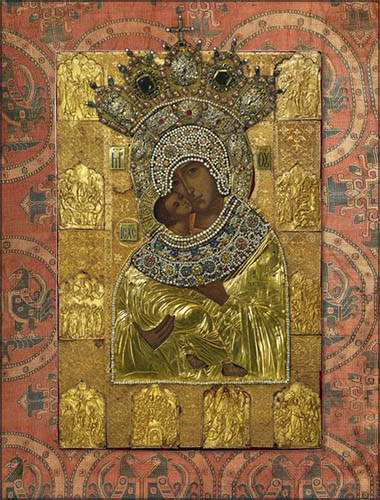

 click here for icons of christ
click here for icons of christ click here for icons of the theotokos
click here for icons of the theotokos click here for icons of angels
click here for icons of angels click here for icons of saints
click here for icons of saints








